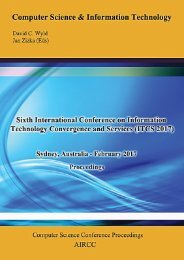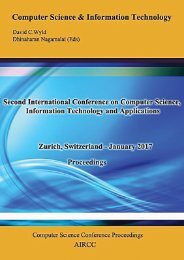CoSIT 2017
Fourth International Conference on Computer Science and Information Technology ( CoSIT 2017 ), Geneva, Switzerland - March 2017
Fourth International Conference on Computer Science and Information Technology ( CoSIT 2017 ), Geneva, Switzerland - March 2017
Create successful ePaper yourself
Turn your PDF publications into a flip-book with our unique Google optimized e-Paper software.
ADAPTIVE AUTOMATA FOR GRAMMAR<br />
BASED TEXT COMPRESSION<br />
Newton Kiyotaka Miura and João José Neto<br />
Escola Politécnica da Universidade de São Paulo, São Paulo, Brazil<br />
ABSTRACT<br />
The Internet and the ubiquitous presence of computing devices anywhere is generating a<br />
continuously growing amount of information. However, the information entropy is not uniform.<br />
It allows the use of data compression algorithms to reduce the demand for more powerful<br />
processors and larger data storage equipment. This paper presents an adaptive rule-driven<br />
device - the adaptive automata - as the device to identify repetitive patterns to be compressed in<br />
a grammar based lossless data compression scheme.<br />
KEYWORDS<br />
Adaptive Automata, Grammar Based Data Compression<br />
1. INTRODUCTION<br />
The amount of data processed by the computers has grown by the increase in hardware computing<br />
power and the data storage capacity. New applications are built to take advantage of this,<br />
reinforcing the need for more capacity in data processing. Currently, analysis of data generated by<br />
social media Internet applications and genome database processing are examples of applications<br />
the requires handling of huge amount of data. In this scenario, the necessity for optimizing the use<br />
of the finite amount of data storage available in computers is economically justifiable.<br />
Grammar-based text compression is a method for representing a sequence of symbols using a<br />
context-free grammar (CFG) as defined in Chomsky’s hierarchy [1], which generates a single<br />
sequence identical to the original one. It is based on the idea that a CFG can compactly represent<br />
the repetitive structures within a text. Intuitively, greater compression would be obtained for input<br />
strings that contain a greater number of repeated substrings that will consequently be represented<br />
by the same grammatical production rule. Examples of data with these characteristics are the<br />
sequences of genes of the same species, texts with version control systems.<br />
The naturally hierarchical definition of a CFG allows string-manipulation algorithms to perform<br />
operations directly on their compressed representations, without the need for a prior<br />
decompression [2] [3] [4] [5]. It potentially brings the advantage of decreasing the temporary<br />
storage space required for data manipulation, in addition to opening the possibility of the<br />
algorithms present shorter execution times by decreasing the data to be processed [2]. These<br />
features are attractive for improving the efficiency in processing large amounts of data whose<br />
demand has grown mainly in Big Data applications and manipulation of genomes.<br />
Dhinaharan Nagamalai et al. (Eds) : <strong>CoSIT</strong>, SIGL, AIAPP, CYBI, CRIS, SEC, DMA - <strong>2017</strong><br />
pp. 173– 183, <strong>2017</strong>. © CS & IT-CSCP <strong>2017</strong><br />
DOI : 10.5121/csit.<strong>2017</strong>.70417





